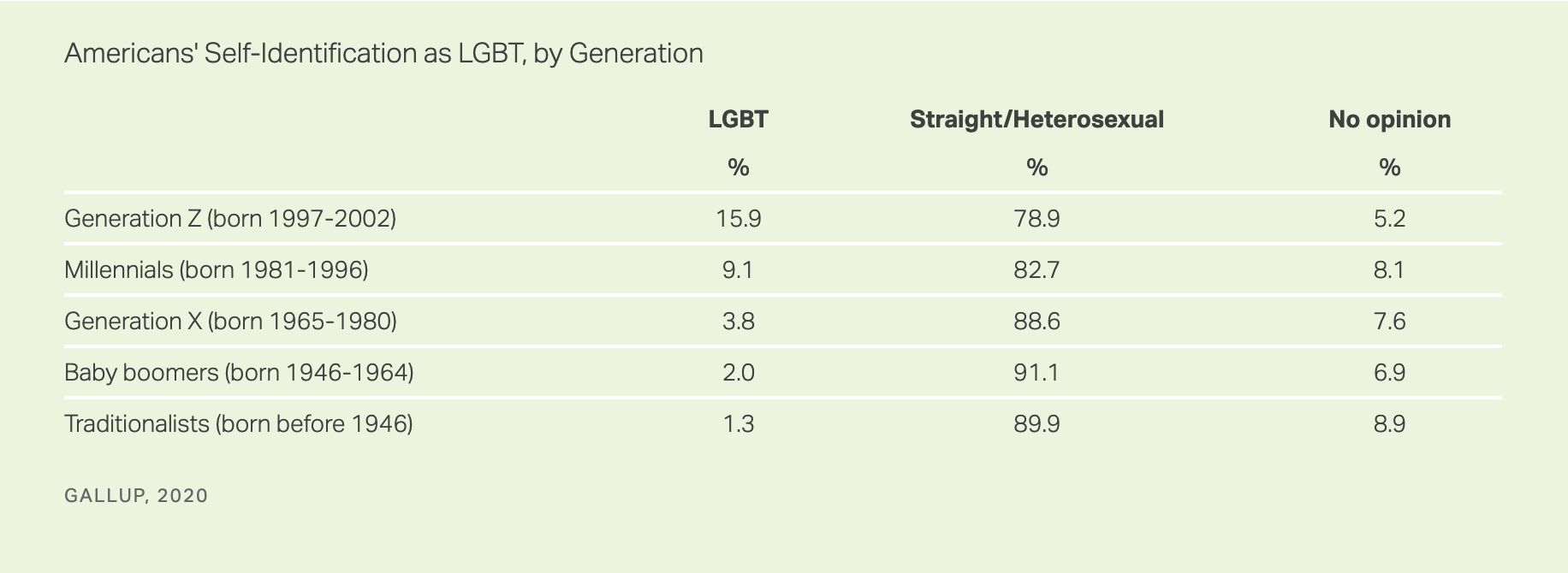According to a newly released Gallup poll, America is getting queerer every year, confirming what many educators around the country have been saying for a number of years.
Gen Z adults, who are either just done with high school or about to be (ages 18 to 23), are far more likely to consider themselves gay, bisexual, trans, or non-binary than than their parents, and more likely even than the Millennial cohort who just preceded them. Among the Americans surveyed by Gallup, 5.6% now self-identify as LGTBQ — up from 4.5% when Gallup conducted similar polling in 2018. And among younger adults, the percentage is far higher, at 15.9%.
The data is based on surveys conducted throughout 2020 with 15,000 Americans over the age of 18.
"The identity question asked in 2020 offers a greater level of detail than the question asked in previous years," Gallup's Jeffrey M. Jones explains. "Now, respondents indicate their precise sexual orientation, rather than simply answering 'yes' or 'no' to whether they identify as lesbian, gay, bisexual or transgender."
A sexual orientation question has never been asked on the U.S. Census, and sociologists and data scientists have instead had to rely on inferences based on same-sex couples cohabitating, generally ignoring vast populations of single gay and queer people and not able to count trans people at all. In recent decades, these figures have typically yielded estimates that between 2% and 4% of the population is LGBT, but Gallup polling has seen that number rise noticeably in just the last eight years, as shown in the chart below. 2% turns out to be the percentage among Baby Boomers, according to Gallup's surveys, with about 4% of Gen X identifying as LGBT, and 9% of Millennials (or Gen Y).

Gallup defines Gen Z as beginning in 1997, and the jury is still out on this — generation splits can be defined by cultural shifts and major events like 9/11, but 1997 has maybe been chosen as the beginning of the Internet Age as we know it?
But with 15.9% of adults between 18 and 23 calling themselves something other than cisgender heterosexual, the percentage has obviously been pushed up quickly. And as more Gen Z-ers reach adulthood in the coming years, the figure could rise much further.

Gallup suggests that cultural acceptance has helped fuel the rise in openness about sexual orientation, and it cautions that older respondents may simply not want to self-identify in a survey, which skews the data.
Gen Zers are more than twice as likely to call themselves bisexual than Millennials — 11.5% vs. 5.1% — and only slightly more likely to call themselves lesbian, gay, or trans.
Among all the adults polled who identified as LGBT, more than half, 54.6%, identified as bisexual, 24.5% identified as gay, 11.7% identified as lesbian, 11.3% identified as trans, and 3.3% identified as queer or some other label.

According to Gallup polling done in 2019, 93% of Americans support equal rights for LGBT people in having jobs, and 83% believe same-sex sexual relations should be legal in all states. 75% of people polled also said that gay people should be allowed to adopt children. When the same question was asked in a 1977 poll, only 14% believed that gay people should be able to adopt.
"At a time when Americans are increasingly supportive of equal rights for gay, lesbian and transgender people, a growing percentage of Americans identify themselves as LGBT," Jones writes. "With younger generations far more likely than older generations to consider themselves LGBT, that growth should continue."
"This poll confirms what we have long known — that the LGBTQ community is powerful and a growing force in the United States, and around the world," says Alphonso David, president of the Human Rights Campaign, in a statement to ABC News. "Young adults, in particular, feel empowered to publicly claim their identities — a compelling finding and validation for the past generations of LGBTQ advocates who have long fought for full equality."
Photo: Mercedes Mehling

